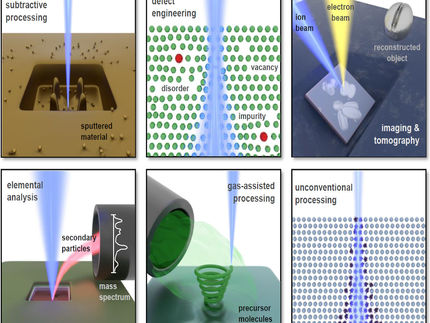New Switching Technology to Migrate Metal Atoms in a Solid Electrolyte
Advertisement
NEC Corporation, the National Institute for Materials Science and the Japan Science and Technology Agency announced the development of a switching technology that migrates metal atoms in a solid electrolyte, and makes it possible to manufacture low-cost, high-performance programmable LSI devices for a wide range of applications. Called NanoBridgea, the switching technology already has been successfully demonstrated in a prototype circuit. Results of the joint research project will be presented February 17 at the International Solid-State Circuit Conference (ISSCC) in San Francisco.
NanoBridge technology uses the atom switching effect of a nanoscale metal bridge, in which an electrically conductive channel is created or annihilated by stretching a metallic bridge controlled by an electrochemical reaction inside a solid electrolyte. With an easy-to-fabricate, highly stable junction structure and a solid electrolyte (Cu2S) with high process immunity, the NanoBridge stabilizes the LSI wiring layer.
As a result, the operating speed of a programmable LSI device, which is indispensable for short-term equipment development, can be increased and the area of the chip reduced, thus improving performance and lowering costs in electronic appliances such as mobile equipment and digital televisions.
Reconfiguration of the circuit also makes it possible to use a single chip for many different functions. For example, in a multi-functional cell phone of the future, having to use dedicated LSI chips for each of those functions would make mounting of the chips problematic in a small case. Using a high-performance programmable LSI device not only would enable all of the functions, including heavy processing, to be done by one chip, it also would facilitate additional processing capabilities by means of communication.
A semiconductor chip is an important component for controlling electronic appliances. Dedicated ASICs, usually cell-based ICs, tailored to match each appliance are widely used. However, competition in the development of appliances recently has become fierce, heightening the importance of reducing development time. As a result, the market share for programmable LSI devices that enable a designer to change a circuit locally has been increasing. Since conventional programmable LSI devices are more expensive and slower in operation than cell-based ICs, the demand is for a low-cost, high-performance programmable LSI chip on a par with a cell-based IC.
NEC Corporation, the National Institute for Materials Science, and the Japan Science and Technology Agency have for some time been promoting joint applied research concerning materials, devices and circuits in order to overcome these problems. The team used NanoBridge technology to make a prototype 4'4 crossbar, which is the basic circuit indispensable for a programmable LSI device, and then changed the voltage application pattern to successfully realize repeated circuit reconfiguration.
About one-thirtieth the size of the SRAM and pass transistor circuit reconfiguration switch used in a conventional programmable LSI device, the NanoBridge switch can be incorporated directly into the wiring layer. It has one-twentieth or less the resistance of the conventional switch.
The compact NanoBridge circuit reconfiguration switch is laminated with the logic block, reducing its chip area to a fraction of a conventional chip's thus resulting in lower costs.
The unit circuit block has been made as small as a primitive gate, and overhead in the circuit configuration has been reduced, thus enabling a wide range of applications to be efficiently realized using a circuit that has been reduced to 1/10th the scale of conventional circuits. The circuit's power efficiency has been improved by around 300% due to the reduction in circuit area.

































































